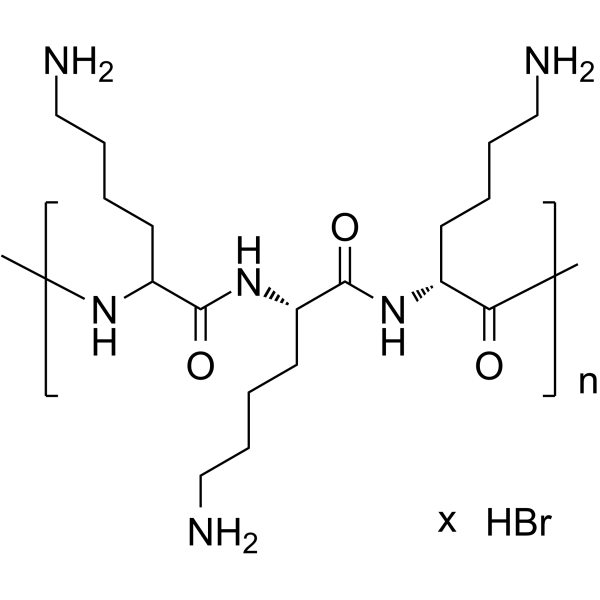Poly-D-lysine hydrobromide (MW 30000-70000)

Poly-D-lysine hydrobromide (MW 30000-70000) structure
|
Common Name | Poly-D-lysine hydrobromide (MW 30000-70000) | ||
|---|---|---|---|---|
| CAS Number | 27964-99-4 | Molecular Weight | 30000-70000 | |
| Density | N/A | Boiling Point | 343.7±0.0 °C at 760 mmHg | |
| Molecular Formula | (C6H14N2O2)x.xBrH | Melting Point | N/A | |
| MSDS | USA | Flash Point | 161.7±0.0 °C | |
Use of Poly-D-lysine hydrobromide (MW 30000-70000)Poly-D-lysine hydrobromide (MW 30000-70000) is a synthetic polymeric substrate and is one of the most widely used substrate in neural cell culture. Poly-D-lysine hydrobromide (MW 30000-70000) removes proteinase K-resistant PrP from prion-infected SN56 neuroblastoma cells without affecting PrPC[1][2]. |
| Name | Lysine hydrobromide (1:1) |
|---|---|
| Synonym | More Synonyms |
| Description | Poly-D-lysine hydrobromide (MW 30000-70000) is a synthetic polymeric substrate and is one of the most widely used substrate in neural cell culture. Poly-D-lysine hydrobromide (MW 30000-70000) removes proteinase K-resistant PrP from prion-infected SN56 neuroblastoma cells without affecting PrPC[1][2]. |
|---|---|
| Related Catalog | |
| In Vitro | Poly-D-lysine is immunogenic in rabbits only when injected at low doses[1]. The approximate concentration of Poly-D-lysine (PDL) needed to lower the amount of PrPres by 50% corresponds to ~0.8 μg/mL or 50 nM[2]. |
| References |
| Boiling Point | 343.7±0.0 °C at 760 mmHg |
|---|---|
| Molecular Formula | (C6H14N2O2)x.xBrH |
| Molecular Weight | 30000-70000 |
| Flash Point | 161.7±0.0 °C |
| Exact Mass | 226.031677 |
| Appearance of Characters | lyophilized powder |
| Vapour Pressure | 0.0±0.0 mmHg at 25°C |
| Storage condition | −20°C |
| Water Solubility | Soluble in water. |
| Personal Protective Equipment | Eyeshields;Gloves;type N95 (US);type P1 (EN143) respirator filter |
|---|---|
| RIDADR | NONH for all modes of transport |
| WGK Germany | 3 |
|
Preclinical evaluation of cyclin dependent kinase 11 and casein kinase 2 survival kinases as RNA interference targets for triple negative breast cancer therapy.
Breast Cancer Res. 17 , 19, (2015) Targeted therapies for aggressive breast cancers like triple negative breast cancer (TNBC) are needed. The use of small interfering RNAs (siRNAs) to disable expression of survival genes provides a too... |
|
|
Stochastic Micro-Pattern for Automated Correlative Fluorescence - Scanning Electron Microscopy.
Sci. Rep. 5 , 17973, (2015) Studies of cellular surface features gain from correlative approaches, where live cell information acquired by fluorescence light microscopy is complemented by ultrastructural information from scannin... |
|
|
Dynamic SUMO modification regulates mitotic chromosome assembly and cell cycle progression in Caenorhabditis elegans.
Nat. Commun. 5 , 5485, (2014) The small ubiquitin-like modifier (SUMO), initially characterized as a suppressor of a mutation in the gene encoding the centromeric protein MIF2, is involved in many aspects of cell cycle regulation.... |
| MFCD00131934 |
| Lysine hydrobromide (1:1) |
| Lysine, hydrobromide (1:1) |

